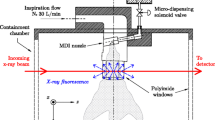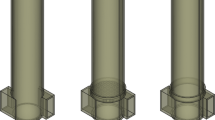ABSTRACT
Purpose
Non-volatile agents such as glycerol are being introduced into solution-based pMDI formulations in order to control mean precipitant droplet size. To assess their biopharmaceutical efficacy, both microscopic and macroscopic characteristics of the plume must be known, including the effects of external factors such as the flow generated by the patient’s inhalation. We test the hypothesis that the macroscopic properties (e.g. spray geometry) of a pMDI spray can be predicted using a self-similarity model, avoiding the need for repeated testing.
Methods
Glycerol-containing and glycerol-free pMDI formulations with matched mass median aerodynamic diameters are investigated. High-speed schlieren imaging is used to extract time-resolved velocity, penetration and spreading angle measurements of the pMDI spray plume. The experimental data are used to validate the analytical model.
Results
The pMDI spray develops in a manner characteristic of a fully-developed steady turbulent jet, supporting the hypothesis. Equivalent glycerol-containing and non glycerol-containing formulations exhibit similar non-dimensional growth rates and follow a self-similar scaling behaviour over a range of physiologically relevant co-flow rates.
Conclusions
Using the proposed model, the mean leading edge penetration, velocity and spreading rate of a pMDI spray may be estimated a priori for any co-flow conditions. The effects of different formulations are captured in two scaling constants. This allows formulators to predict the effects of variation between pMDIs without the need for repeated testing. Ultimately, this approach will allow pharmaceutical scientists to rapidly test a number of variables during pMDI development.











Similar content being viewed by others
Abbreviations
- ACI:
-
Andersen Cascade Impactor
- BDP:
-
Beclomethasone dipropionate
- FPD:
-
Fine particle dose
- HFA:
-
Hydrofluoroalkane
- MMAD:
-
Mass median aerodynamic diameter
- pMDI:
-
Pressurised Metered Dose Inhaler
REFERENCES
Newhouse M. Advantages of pressurized canister metered dose inhalers. J Aerosol Med. 1991;4(3):139–50.
Finlay WH. The mechanics of inhaled pharmaceutical aerosols - an introduction. Academic Press; 2001.
Ross DL, Schultz RK. Effect of inhalation flow rate on the dosing characteristics of dry powder inhaler (DPI) and metered dose inhaler (MDI) products. J Aerosol Med. 1996;9(2):215–26.
Lewis DA, Young PM, Buttini F, Church T, Colombo P, Forbes B, et al. Towards the bioequivalence of pressurised metered dose inhalers 1: design and characterisation of aero-dynamically equivalent beclomethasone dipropionate inhalers with and without glycerol 2 as a non-volatile excipient. Eur J Pharm Biopharm. 2013.
Keller M. Innovations and perspectives of metered dose inhalers in pulmonary drug delivery. Int J Pharm. 1999;186:81–90.
Haghi M, Bebawy M, Colombo P, Forbes B, Lewis DA, Salama R, et al. Towards the bioequivalence of pressurised metered dose inhalers 2. Aerodynamically equivalent particles (with and without glycerol) exhibit different biopharmaceutical profiles in vitro. Eur J Pharm Biopharm. 2013.
Brambilla G, Ganderton D, Garzia R, Lewis D, Meakin B, Ventura P. Modulation of aerosol clouds produced by pressurised inhalation aerosols. Int J Pharm. 1999;186(1):53–61.
Versteeg HK, Hargrave GK, Kirby M. Internal flow and near-orifice spray visualisations of a model pharmaceutical pressurised metered dose inhaler. J Phys Conf Ser. 2006;45(1):207.
Tzou TZ. Aerodynamic particle size of metered-dose inhalers determined by the quartz crystal microbalance and the Andersen cascade impactor. Int J Pharm. 1999;186:71–9.
May KR. Multistage liquid impinger. Bacteriol Rev. 1966;30:559–70.
Marple VA, Roberts DL, Romay FJ, Miller NC, Truman KG, Van Oort M, et al. Next generation pharmaceutical impactor (a new impactor for pharmaceutical inhaler testing). Part I: design. J Aerosol Med. 2003;16:283–99.
Liu X, Doub WH, Guo C. Evaluation of metered dose inhaler spray velocities using Phase Doppler Anemometry (PDA). Int J Pharm. 2012;423:235–9.
Dunbar CA, Hickey AJ. Selected parameters affecting characterization of nebulized aqueous solutions by inertial impaction and comparison with phase-Doppler analysis. Eur J Pharm Biopharm. 1999;48(2):171–7.
Ma Z, Merkus HG, de Smet JG, Heffels C, Scarlett B. New developments in particle characterization by laser diffraction: size and shape. Powder Technol. 2000;111(1):66–78.
Dunbar CA. Atomization mechanisms of the pressurized metered dose inhaler. Part Sci Technol. 1997;15(3–4):253–71.
Crosland BM, Johnson MR, Matida EA. Characterization of the spray velocities from a pressurized metered-dose inhaler. J Aerosol Med Pulm Drug Deliv. 2009;22(2):85–98.
Roisman IV, Araneo L, Tropea C. Effect of ambient pressure on penetration of a diesel spray. Int J Multiphase Flow. 2007;33:904–20.
Sweeney TD, Blanchard JD, Zeltner TB, Cater JE, Brain JD. Delivery of aerosolized drugs to the lungs with a metered-dose inhaler: quantitative analysis of regional deposition. J Aerosol Sci. 1990;21(3):350–4.
Clark AR. MDIs: physics of aerosol formation. J Aerosol Med. 1996;9(S1):19–26.
Smyth H, Hickey AJ, Brace G, Barbour T, Gallion J, Grove J. Spray pattern analysis for metered dose inhalers I: orifice size, particle size, and droplet motion correlations. Drug Dev Ind Pharm. 2006;32(9):1033–41.
Dhand R, Malik SK, Balakrishnan M, Verma SR. High speed photographic analysis of aerosols produced by metered dose inhalers. J Pharm Pharamcol. 1988;40:429–30.
Hajialimohammadi A, Honnery D, Abdullah A, Mirsalim MA. Time resolved characteristics of gaseous jet injected by a group-hole nozzle. Fuel. 2013;113:497–505.
Kostas J, Honnery D, Soria J. A correlation image velocimetry-based study of high-pressure fuel spray tip evolution. Exp Fluids. 2011;51:667–78.
Settles GS. Schlieren and shadowgraph techniques. experimental fluid mechanics. Springer-Verlag; 2001.
Mitchell D, Honnery D, Soria J. The visualization of the acoustic feedback loop in impinging underexpanded supersonic jet flows using ultra-high frame rate Schlieren. J Vis. 2012;15(7):333–41.
Buchmann NA, Willert CE, Soria J. Pulsed, high-power LED illumination for tomographic particle image velocimetry. Exp Fluids. 2012;53:1545–60.
Willert CE, Mitchell DM, Soria J. An assessment of high-power light-emitting diodes for high frame rate schlieren imaging. Exp Fluids. 2012;53(2):413–21.
Canny J. A computational approach to edge detection. IEEE Trans Pattern Anal Mach Intell. 1986;8(6):679–98.
Duke D, Honnery D, Soria J. A comparison of subpixel edge detection and correlation algorithms for the measurement of sprays. Int J Spray Combust Dyn. 2011;3(2):93–109.
Duke D, Honnery D, Soria J. A cross-correlation velocimetry technique for breakup of an annular liquid sheet. Exp Fluids. 2010;49:435–45.
Duke D, Honnery D, Soria J. Experimental investigation of nonlinear instabilities in annular liquid sheets. J Fluid Mech. 2011;691:594–604.
Westerweel J, Scarano F. Universal outlier detection for PIV data. Exp Fluids. 2005;39(6):1096–100.
Clark AR. Metered atomisation for respiratory drug delivery. Loughborough University; 1991.
Hiroyasu H, Arai M. Structures of fuel sprays in diesel engines. SAE J. 1990 Feb;900475.
Pastor JV, López JJ, García J, Pastor JM. A 1D model for the description of mixing-controlled inert diesel sprays. Fuel. 2008;87(13–14):2871–85.
Ricou FP, Spalding DB. Measurements of entrainment by axisymmetrical turbulent jets. J Fluid Mech. 1961;11(1):21–32.
Shaik AQ. Numerical modeling of two-phase flashing propellant flow inside the twin-orifice system of pressurized metered dose inhalers (PMDIs). Loughborough University; 2010.
Kostas J, Honnery D, Soria J. Time resolved measurements of the initial stages of fuel spray penetration. Fuel. 2009;88(11):2225–37.
White FM. Fluid mechanics. 4th ed. Singapore: McGraw-Hill; 1999.
Ihmels EC, Horstmann S, Fischer K, Scalabrin G, Gmehling J. Compressed liquid and supercritical densities of 1, 1, 1, 2, 3, 3, 3-heptafluoropropane (R227ea). Int J Thermophys. 2002;23(6):1571–85.
Huber ML, McLinden MO. Thermodynamic properties of R134a (1, 1, 1, 2-tetrafluoroethane). In: International Refridgeration and Air Conditioning Conference; 1992.
ACKNOWLEDGMENTS AND DISCLOSURES
The authors would like to acknowledge the financial support of the Australian Research Council (grant number DP120103510).
Author information
Authors and Affiliations
Corresponding author
Appendix
Appendix
In order to calculate the peak velocity, we must first define the jet exit velocity at the orifice (39);
where p vap is the propellant vapour pressure (as per Table III) and C D is the nozzle discharge coefficient. ρ m,γ is the density of the propellant liquid-vapour mixture at the liquid fraction γ; it has been estimated using vapour and liquid state densities and quantities derived from thermodynamic tables for the respective propellants (40,41). C D is solved using the known metered dosage of the drug and the average spray duration to estimate the mass flow rate m, which gives
where A is the nozzle area. For these experiments, we find C D ≈ 0.8, which is in very good agreement with the measurements of Clark (33) who found C D ≈ 0.78 for all conditions for a similarly designed metered dose aerosol. It should be noted that C D can vary depending on the pMDI geometry, so care should be taken in assuming a value for C D if the metering chamber and orifice dimensions are substantially altered (33).
Once U m is known, the characteristic peak spray velocity U p can be estimated using the model of Roisman et al. (17);
where κ, γ, p a and ρ a are the propellant specific heat ratio, liquid volume fraction, ambient pressure and density respectively. Properties for the pMDIs studied here are given in Table III. p c is the unknown pressure at the leading edge as a function of the peak tip velocity U p ; both variables are solved simultaneously in the above equations to yield U p = f(Um, κ, γ, p a , ρ a ). We note that γ is an estimate, since the thermodynamic non-equilibrium of the mixture makes it difficult to know the state of the mixture at the nozzle. Models of pMDI sprays such as the one-dimensional models of Clark (33) cannot provide this information since they only indicate quantities at thermal equilibrium; the quantities at the nozzle exit during the transient spray are in a non-equilibrium state. Improving estimates for γ will be a matter for further investigation.
Rights and permissions
About this article
Cite this article
Buchmann, N.A., Duke, D.J., Shakiba, S.A. et al. A Novel High-Speed Imaging Technique to Predict the Macroscopic Spray Characteristics of Solution Based Pressurised Metered Dose Inhalers. Pharm Res 31, 2963–2974 (2014). https://doi.org/10.1007/s11095-014-1391-6
Received:
Accepted:
Published:
Issue Date:
DOI: https://doi.org/10.1007/s11095-014-1391-6




